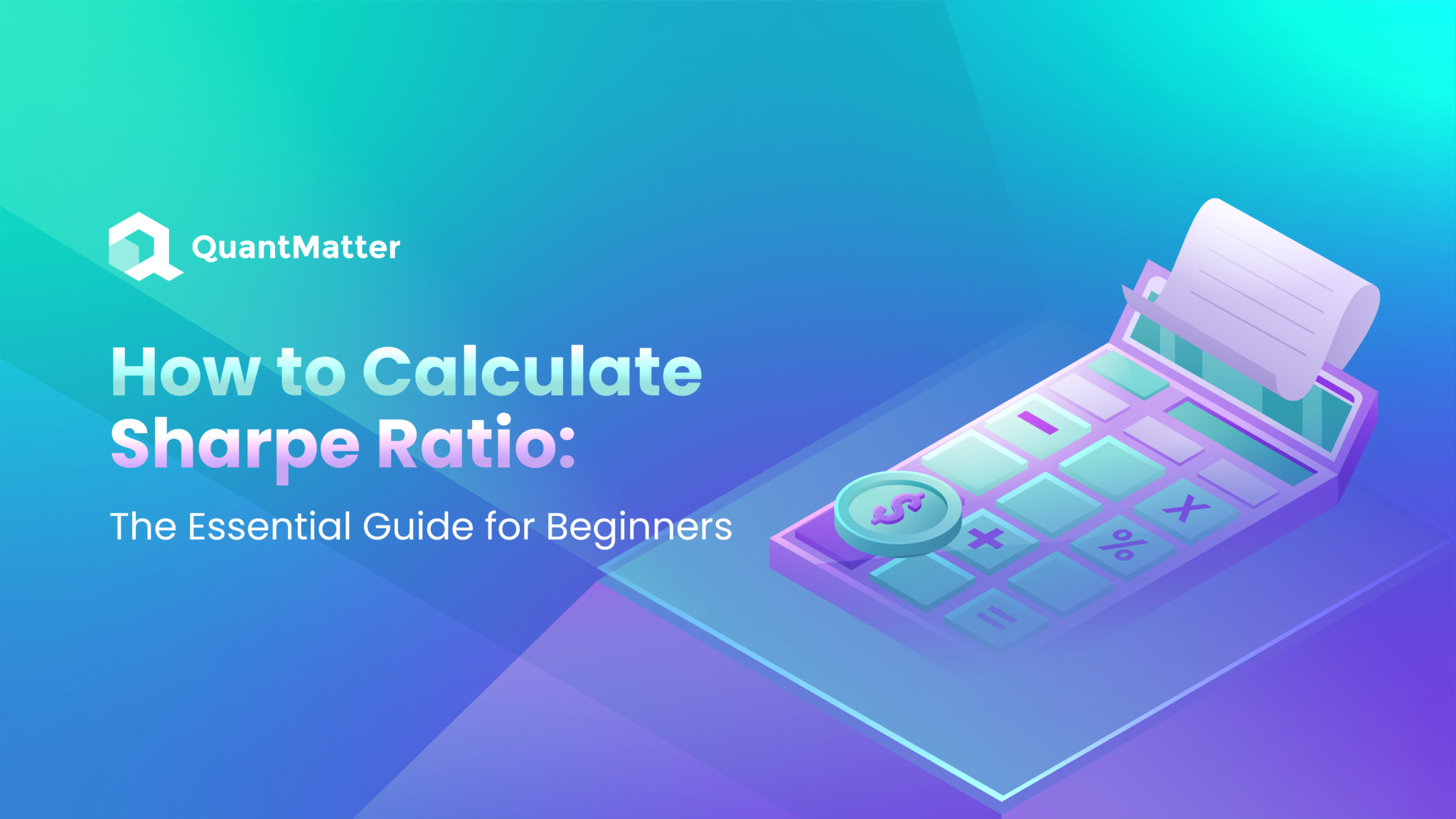
Investing can be overwhelming for beginners. With so many options and strategies available, evaluating which investments work best for your goals is challenging. One commonly used method for comparing investments is the Sharpe ratio, a metric that measures risk-adjusted return.
The Sharpe ratio provides a clearer picture of an investment’s performance by considering both return and risk. Instead of simply focusing on how much money an investment makes, the Sharpe ratio highlights how efficiently the investment generates those returns relative to the level of risk it carries.
This guide is here to simplify the process of calculating the Sharpe ratio, explain why it’s useful, and show how you can apply it in real-world scenarios. Let’s break it down step by step so you can start making better-informed financial decisions.
What Is the Sharpe Ratio?

The Sharpe ratio is a formula that helps investors evaluate the return of an investment compared to its risk. It was developed by Nobel laureate William F. Sharpe and is widely used in finance to analyze and compare the performance of different portfolios, funds, or individual assets.
In simple terms, the Sharpe ratio measures how much return an investment earns for every unit of risk. A higher Sharpe ratio indicates that the investment has a better risk-adjusted return, while a lower ratio might suggest that the returns are not worth the risk taken.
The formula for the Sharpe ratio is:
Sharpe Ratio = (Rp – Rf) / σ
- Rp: The return of the portfolio or investment
- Rf: The risk-free rate of return (usually government bond yields)
- σ: The standard deviation of the investment’s return, which represents risk
Why Is the Sharpe Ratio Important?

The Sharpe ratio might sound like just another complicated finance term, but it’s surprisingly simple and incredibly useful. Whether you’re a seasoned investor or just starting out, understanding this metric can transform how you approach your investments. Let’s dive into why the Sharpe ratio matters and how you can use it to make smarter decisions.
1. Balances Risk and Reward
Investing isn’t just about finding the highest returns—it’s about understanding what you’re risking to get there. A high return investment might look tempting, but if it comes with sky-high risks, you could lose more than you gain. That’s where the Sharpe ratio steps in. It evaluates not just how much you’re earning but how much risk you’re taking to earn it.
- Why It Matters: Think of it as a reality check. An investment with stellar returns but a low Sharpe ratio might not be worth it. For example, if you’re earning 10% annually but taking on significant risk, you’re essentially walking a tightrope without a safety net.
- Quick Tip: Start using the Sharpe ratio to assess your portfolio. Investments with a higher Sharpe ratio typically offer better risk-adjusted returns, meaning you’re earning more per unit of risk taken. This is especially helpful when you’re tempted to chase high returns without thinking about potential losses.
2. Makes Comparing Investments Easy
Choosing between investments can feel overwhelming, especially when they come with different risk and return profiles. One might offer a steady but moderate return, while another promises higher returns but feels riskier. Without a standardized way to compare them, you might make decisions based on guesswork. The Sharpe ratio changes that by giving you a clear, apples-to-apples comparison.
- Why It Matters: Imagine you’re deciding between two funds. Fund A has a 12% return with high volatility, while Fund B offers an 8% return with moderate volatility. By comparing their Sharpe ratios, you might find that Fund B offers a better risk-adjusted return, even though the raw return is lower. This insight can prevent you from falling into the “bigger is better” trap.
- Quick Tip: Use financial tools or apps to calculate the Sharpe ratios for investments you’re considering. Many investment platforms include this feature, so you don’t need to be a math whiz. Focus on options with higher ratios to make more balanced decisions.
3. Helps You Build a Smarter Portfolio
A well-diversified portfolio is the cornerstone of smart investing, but diversification isn’t just about picking a variety of assets. It’s about finding the right mix that maximizes returns while keeping risks manageable. The Sharpe ratio can guide you here, showing which investments will likely improve your portfolio’s overall performance.
- Why It Matters: Let’s say your portfolio includes stocks, bonds, and mutual funds. By analyzing the Sharpe ratios of each, you can identify which ones are pulling their weight and which might be dragging you down. This helps you allocate your money more effectively. For instance, replacing a low Sharpe ratio investment with a higher one could boost your portfolio’s returns without adding extra risk.
- Quick Tip: Review your portfolio regularly and calculate the Sharpe ratios for all your holdings. Pay close attention to those with low ratios—they might be adding unnecessary risk without enough reward. Gradually shift toward investments with higher Sharpe ratios to create a more efficient portfolio.
How to Use the Sharpe Ratio in Your Investment Strategy
If you’re ready to put the Sharpe ratio to work, here’s how you can get started:
- Calculate Your Ratios: Begin with one or two of your investments. Use an online Sharpe ratio calculator or financial app to see how your returns stack up against the risks.
- Compare Options: When adding new investments, use the Sharpe ratio as a key deciding factor. It’s especially useful when evaluating different funds or asset classes.
- Optimize Your Portfolio: Identify the investments with the highest Sharpe ratios and allocate more resources to them. Don’t forget to review your portfolio periodically, as Sharpe ratios can change with market conditions.
- Avoid Tunnel Vision: While the Sharpe ratio is a powerful tool, don’t rely on it alone. Use it alongside other metrics like beta, alpha, and standard deviation for a more comprehensive view of your investments.
The Sharpe ratio is more than just a number—it’s a tool that can help you make better, smarter choices in your investment journey. By balancing risk and reward, simplifying comparisons, and guiding portfolio decisions, it gives you the clarity you need in a complex financial world. Start incorporating it into your strategy today, and watch your confidence (and your portfolio) grow!
Also Read: 5 Ways to Navigate Challenges in Market Research
How to Calculate the Sharpe Ratio

Let’s dive into the step-by-step process of calculating the Sharpe ratio. We’ll break it down into smaller, manageable steps.
Step 1: Gather the Required Data
Before you can calculate the Sharpe ratio, you’ll need three pieces of information:
- Investment Return (Rp): This can be the historical or expected return of your investment.
- Risk-Free Rate (Rf): The return from a risk-free asset, often a government bond.
- Standard Deviation (σ): The measure of how much the investment’s returns fluctuate.
Step 2: Subtract the Risk-Free Rate from the Investment Return
This step isolates the “excess return,” or the portion of the return earned above the risk-free rate:
Excess Return = Rp – Rf
For example, if an investment has a return of 10% and the risk-free rate is 2%, the excess return is:
10% – 2% = 8%
Step 3: Divide the Excess Return by the Standard Deviation
Next, take the excess return and divide it by the standard deviation of the investment’s return:
Sharpe Ratio = Excess Return / σ
For instance, if the standard deviation of the investment is 12%, the Sharpe ratio would be:
8% ÷ 12% = 0.67
This means the investment earns 0.67 units of return for every unit of risk.
Also Read: Compound Interest: How We Applicate It In The Real World?
Interpreting the Sharpe Ratio and Practical Applications
Once you’ve calculated the Sharpe ratio, what does it mean? Here’s a quick guide to interpreting the results:
- Sharpe Ratio > 1: A good risk-adjusted return.
- Sharpe Ratio = 1: The return is proportional to the risk.
- Sharpe Ratio < 1: The risk outweighs the return.
While these are general benchmarks, context matters. For example, a Sharpe ratio of 0.8 might be acceptable in volatile markets, while in stable markets, you may aim for ratios above 1.5.
Practical Applications of the Sharpe Ratio
When deciding where to invest your hard-earned money, you want more than just big returns — you want the right balance between risk and reward. This is where the Sharpe ratio comes in handy. Think of it as a tool to measure how well an investment rewards you for taking on risk. Let’s dive into some practical ways you can use the Sharpe ratio to make smarter financial choices.
Comparing Two Investments: Which One Is Really Better?
Imagine you’re evaluating two mutual funds, and here’s what they offer:
| Fund | Return | Risk (Standard Deviation) | Risk-Free Rate | Sharpe Ratio |
| Fund A | 12% | 15% | 2% | (12% – 2%) ÷ 15% = 0.67 |
| Fund B | 10% | 8% | 2% | (10% – 2%) ÷ 8% = 1.00 |
At first glance, Fund A’s higher return might grab your attention. But when you look at risk-adjusted performance, Fund B wins the game. With a Sharpe ratio of 1.00, Fund B gives you more bang for your buck while taking on less risk.
Takeaway: A higher return doesn’t always mean a better investment. Consider the Sharpe ratio to understand if the returns justify the risk.
Portfolio Diversification: Balancing Risk and Reward
Think of your investment portfolio as a team. Each investment plays a role, but not every player is a star. By using the Sharpe ratio, you can decide which “players” deserve to stay on your team. For example:
| Investment | Return | Risk (Standard Deviation) | Risk-Free Rate | Sharpe Ratio |
| Stock A | 8% | 10% | 2% | 0.6 |
| Stock B | 10% | 20% | 2% | 0.4 |
| Stock C | 6% | 5% | 2% | 0.8 |
Based on this table, Stock C has the highest Sharpe ratio, meaning it offers the best risk-adjusted return. Stock B, on the other hand, might need to be replaced with a better-performing investment.
Pro Tip: Use the Sharpe ratio to weed out low-performing assets and replace them with ones that offer higher risk-adjusted returns.
Assessing Active Management: Are You Getting What You Pay For?
If you’re paying fees for an actively managed mutual fund, you want to know if it’s worth the cost. The Sharpe ratio can help you evaluate whether the manager is delivering enough value to justify those fees.
High Sharpe Ratio: The fund manager is doing a good job balancing returns and risk.
Low Sharpe Ratio: You might be better off with a low-cost index fund or ETF.
| Fund Type | Return | Risk (Standard Deviation) | Risk-Free Rate | Sharpe Ratio |
| Actively Managed Fund | 9% | 12% | 2% | 0.58 |
| Index Fund | 8% | 10% | 2% | 0.6 |
In this case, the index fund outperforms the actively managed fund on a risk-adjusted basis — and likely with lower fees!
Money-Saving Tip: Use the Sharpe ratio to see if your fund manager is earning their keep, or if you’d be better off with a simpler, cheaper option.
The Sharpe ratio isn’t just a number — it’s your guide to making better investment decisions. Whether you’re comparing funds, fine-tuning your portfolio, or questioning the value of active management, this tool simplifies the process.
Limitations of the Sharpe Ratio and Tools for Calculating
While the Sharpe ratio is a valuable tool, it’s not perfect. Here are some limitations to keep in mind:
- Assumes Normal Distribution of Returns: The Sharpe ratio works best for investments with returns that follow a bell curve. If returns are skewed, the metric may be misleading.
- Relies on Past Performance: Historical data may not predict future performance accurately.
- Ignores Tail Risks: The Sharpe ratio doesn’t account for extreme events like market crashes.
To address these limitations, consider using other metrics like Sortino ratio or beta alongside the Sharpe ratio.
Tools for Calculating Sharpe Ratio
Manually calculating the Sharpe ratio can be time-consuming, especially for large portfolios. Luckily, there are tools available to make the process easier:
- Excel or Google Sheets: You can use built-in functions to calculate returns, standard deviation, and the Sharpe ratio.
- Financial Calculators: Many online calculators allow you to input the required data and get results instantly.
- Investment Platforms: Many brokers and portfolio managers provide Sharpe ratio calculations as part of their analytics tools.
Conclusion
The Sharpe ratio is an essential tool for evaluating investments. It provides a clear picture of how much return an investment delivers compared to its risk. By understanding and applying this metric, you can make smarter decisions and build a portfolio that aligns with your financial goals.
Remember, no single metric can capture all aspects of an investment. While the Sharpe ratio is valuable, consider using it alongside other tools and strategies to get a complete view of your investments.
Start calculating the Sharpe ratio today and take a step toward making more informed, confident investment choices. The effort you put into understanding your investments now will pay off in the long run.
Disclaimer: The information provided by Quant Matter in this article is intended for general informational purposes and does not reflect the company’s opinion. It is not intended as investment advice or a recommendation. Readers are strongly advised to conduct their own thorough research and consult with a qualified financial advisor before making any financial decisions.

I'm Carina, a passionate crypto trader, analyst, and enthusiast. With years of experience in the thrilling world of cryptocurrency, I have dedicated my time to understanding the complexities and trends of this ever-evolving industry.
Through my expertise, I strive to empower individuals with the knowledge and tools they need to navigate the exciting realm of digital assets. Whether you're a seasoned investor or a curious beginner, I'm here to share valuable insights, practical tips, and comprehensive analyses to help you make informed decisions in the crypto space.
- Carinahttps://quantmatter.com/author/carina/
- Carinahttps://quantmatter.com/author/carina/
- Carinahttps://quantmatter.com/author/carina/
- Carinahttps://quantmatter.com/author/carina/
